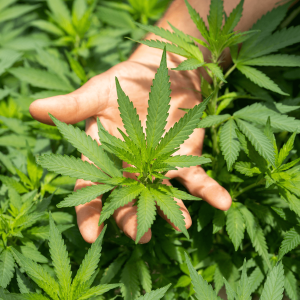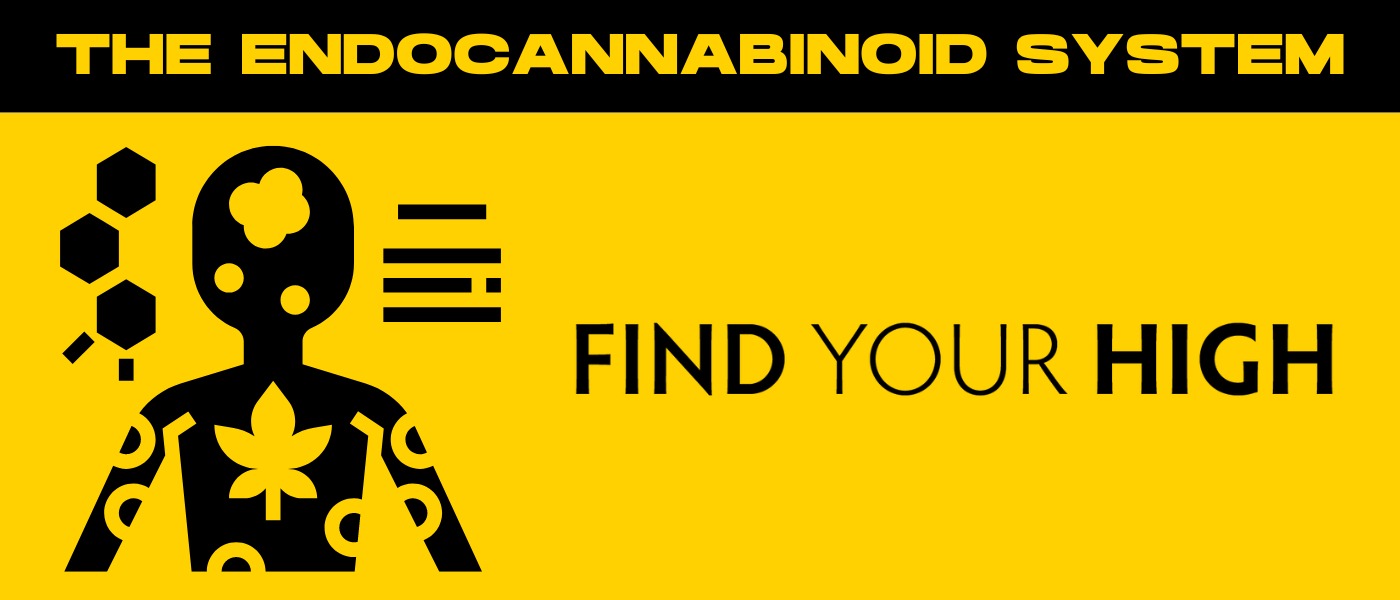We’ve all been there: high as a kite and curious as to how we got this way. Enter the endocannabinoid system.
A built-in biological superpower, the endocannabinoid system (ECS) is a complex network of cellular receptors and chemical signals. In other words, it’s the body’s cannabinoid signaling system.
And as the body’s cannabinoid signaling system, the endocannabinoid system regulates many of the body’s most critical functions. These include learning, sleep, memory, and hunger — among others.
Since its discovery in the early 1990s, researchers have settled on the simple fact that the endocannabinoid system is complicated. But given that the best things in life typically are, we’re intrigued.
In this blog, we’re taking a deep dive into the secret, complicated world of the endocannabinoid system. From the fundamentals of the ECS to its impact on various aspects of our health, this guide will provide an in-depth look at how the ECS works and its potential therapeutic benefits.
By understanding the ECS, we can better harness its power to improve our health and overall well-being, allowing us to thrive in today’s demanding world. So without further ado, keep reading to discover how it works, why it works, and everything in between.
Short Summary
- The Endocannabinoid System (ECS) is a complex cell-signaling system that helps maintain homeostasis and regulate physiological processes.
- Exogenous cannabinoids, such as THC and CBD, have distinct mechanisms of action which can be used to explore potential therapeutic benefits.
- Targeting the ECS through pharmacological interventions or lifestyle modifications holds great potential for treating various health conditions.
Components of the Endocannabinoid System
The endocannabinoid system (ECS), also known as the cannabinoid signaling system, is a complex cell-signaling system that plays a crucial role in maintaining homeostasis and regulating various physiological processes in the body.
This intricate system can be found throughout the human body, including in the central nervous system, peripheral tissues, and immune cells.

But to understand how the endocannabinoid system works, we need to first understand why it works.
The endocannabinoid system is comprised of three essential components: endocannabinoids, receptors, and enzymes.
And if you’re sitting there scratching your head and wondering what we’re talking about, you’re in luck.
Endocannabinoids: Anandamide and 2-AG
Endogenous cannabinoids, more commonly known as endocannabinoids, are simply molecules naturally produced by the body. By activation of certain G protein-coupled receptors or by depolarization, endocannabinoid production begins, and endocannabinoids are released in the extracellular space.
But here’s the interesting part about endocannabinoids — They resemble cannabinoids found within the cannabis plant.

As of publication, only two endocannabinoids have been discovered:
- Anandamide (AEA): AEA favors CB1 receptors, and regulates appetite and energy balance through the nervous system.
- 2-arachidonoylglyerol (2-AG): 2-AG is an endocannabinoid that activates the cannabinoid CB1 receptor. It’s involved in the regulation of bodily functions, such as energy balance, cognition, and pain sensation.
And both 2-AG and AEA are lipid-based neurotransmitters, meaning they act as chemical messengers that send signals between nerve cells.
Note that exogenous cannabinoids are different from endogenous cannabinoids. While endocannabinoids are naturally produced by the body, exogenous cannabinoids are either plant-based or synthetic cannabinoids.
Research has demonstrated that endocannabinoids can have significant effects on our brains, particularly in the area of memory and cognitive processes.
For example, activation of mitochondrial CB1 receptors in the hippocampus has been associated with memory impairment. Activation of astrocytic mitochondrial CB1 receptors has been demonstrated to have an effect on neuronal functioning and animal behavior. It is associated with reduced glucose metabolism and lactate formation in the brain.
Receptors: CB1 and CB2
But in order to have any influence, the endocannabinoids need something to attach to.
Enter cannabinoid receptors.
Cannabinoid receptors, including the cannabinoid receptor, are cell-surface proteins located throughout the body, responsible for mediating the effects of endocannabinoids and exogenous cannabinoids. These receptors are a type of g protein-coupled receptors.
In other words, AEA and 2-AG attach to receptors, sending a message to the endocannabinoid system to signal a response.
Researchers have discovered two primary cannabinoid receptors:
- CB1 Receptors: Present in the central nervous system. Endocannabinoids may attach to CB1 receptors in the spinal cord to relieve pain, such as spinal nerve pain.
- CB2 Receptors: Present in the peripheral nervous system. Endocannabinoids may attach to CB2 receptors in immune cells to reduce inflammation.
Note that AEA and 2-AG are free to attach to either type of cannabinoid receptor, whether CB1 receptors or CB2 receptors. When endocannabinoids bind to CB1 or CB2 receptors, they trigger a response within the ECS, initiating a variety of physiological processes.
Endocannabinoids can bind to either CB1 receptors in neurons or to CB2 receptors in immune cells. For example, binding to a spinal nerve of the former could provide relief from pain, while the latter might signal that the body is experiencing inflammation.
Enzymes: FAAH and MAGL
And finally, we’ve reached the topic of enzymes. In particular, FAAH and MAGL.
Maybe those are random letters we’ve strung together. Or maybe, they’re acronyms for the two primary enzymes that break down the endocannabinoids after they’ve attached to receptors and carried out their needed response.
Enzymes play a crucial role in the ECS, as they are responsible for breaking down endocannabinoids once they have fulfilled their purpose.
FAAH stands for fatty acid amide hydrolase. This particular enzyme breaks down the endocannabinoid, anandamide (AEA). Research has shown that individuals with mutations in the FAAH gene may be more predisposed to drug and alcohol abuse, highlighting the importance of understanding the role enzymes play in the ECS.
Monoacylglycerol acid lipase, otherwise known as MAGL, breaks down the endocannabinoid, 2-arachidonoylglyerol (2-AG).
So basically, enzymes act as the cleaning crew for the endocannabinoid system (ECS).
In addition to breaking down endocannabinoids, enzymes are also involved in their synthesis. For example, anandamide is synthesized from arachidonic acid, a polyunsaturated fatty acid.
Functions of the Endocannabinoid System
Remember when we said that the endocannabinoid system as like a built-in superpower? Let us explain…
Overall, the endocannabinoid system partly influences how well the body functions. For example, maintaining homeostasis.
Homeostasis refers to the overall stability of the body’s internal environment. And the endocannabinoid system plays a role in maintaining homeostasis by helping the body to return to normalcy if something were to throw off temperature, blood sugar, or appetite.
Another unique aspect of the ECS is its interaction with sex hormones, such as estrogen and testosterone. Research has shown that the ECS and sex hormones mutually regulate each other in the central nervous system and peripheral tissues, such as the uterus, gut, and adipose tissue.
Aside from homeostasis, the endocannabinoid system influences a number of other bodily functions, such as:
Regulation of Appetite and Metabolism
Among the most basic human behaviors is the human behavior to eat. Simple enough, right?
The endocannabinoid system plays a role in regulating both appetite and metabolism through the CB1 receptors. In other words, CB1 receptor signaling can increase appetite. Whereas blockage of CB1 receptors suppresses hunger to help with appetite control.
Additionally, plenty of research points to the idea that the endocannabinoid system plays an influential role in energy balance regulation.
This process refers to the endocannabinoid system (ECS) favoring energy deposition through increasing energy intake and reducing energy expenditure. Ultimately, this regulates energy balance and metabolism.
Brain Function and Neuroprotection
The ECS plays a vital role in neuroprotection, memory, and cognitive processes, making it a potential target for treating neurodegenerative diseases.
In fact, research has shown that disturbances in endocannabinoid system homeostasis are associated with Parkinson’s disease pathology in both human and animal models.
Pain Sensation and Inflammation
It’s no surprise that a vast number of medical cannabis consumers use marijuana for relief from pain and inflammation.
What may come as a surprise, however, is that the endocannabinoid system is one of the key endogenous systems regulating pain sensations within the body.
Signals from both CB1 receptors and CB2 receptors are believed to play a role in resolving acute pain, such as that caused by the body’s response to an injury.
In regards to inflammation, endocannabinoids play a role in the immune cells. Immune cells generate and secrete AEA and 2-AG, which changes immune-cell behavior to influence tissue inflammation.
Immune Regulation
The ECS is involved in immune system regulation, contributing to the balance between pro-inflammatory and anti-inflammatory responses.
By modulating the production of cytokines and other molecules, the ECS helps maintain this delicate balance, ensuring that our immune system functions optimally.
Mood and Anxiety
Next up are mood and anxiety, two of the most common reasons for cannabis consumption — not like a reason is needed, of course.
Anyways, the endogenous cannabinoid system regulates mood and anxiety through—you guessed it—CB1 receptors.
When a 2-AG endocannabinoid binds to a CB1 receptor, it sends a signal to exert regulatory control over emotional behavior, including mood, stress, and anxiety.
Exogenous Cannabinoids: THC and CBD
Exogenous cannabinoids, such as THC and CBD, interact with the ECS in different ways to offer potential therapeutic benefits.
THC, the psychoactive component of cannabis, binds directly to CB1 and CB2 receptors — similar to 2-AG and AEA. When THC binds to an endocannabinoid receptor, it produces both positive and negative effects, including pain relief and the psychoactive experiences stoners are familiar with.
In contrast, CBD does not directly bind to these receptors but may enhance endocannabinoid signaling by inhibiting their breakdown. This action provides additional evidence that CBD is non-psychoactive, and could even potentially alleviate the psychoactive effects associated with THC.
THC Interaction with the Endocannabinoid System
THC binds to CB1 and CB2 receptors, producing both positive and negative effects, including pain relief and psychoactive experiences. Research suggests that THC may have beneficial effects such as reducing pain and stimulating appetite. AKA — the munchies.
However, THC is also known to cause paranoia and anxiety in some individuals.
CBD’s Unique Mechanism of Action
CBD does not directly bind to CB1 or CB2 receptors but may enhance endocannabinoid signaling by inhibiting their breakdown.
This unique mechanism of action allows CBD to provide various health benefits without the psychoactive effects associated with THC.
By targeting the ECS with CBD, we can potentially harness its therapeutic potential for a wide range of health conditions, from pain and inflammation to anxiety and epilepsy.
Endocannabinoid System Dysfunction and Clinical Implications
ECS dysfunction may contribute to certain conditions, and targeting the ECS often offers potential therapeutic benefits.
For example, the Clinical Endocannabinoid Deficiency (CECD) theory suggests that low endocannabinoid levels or ECS dysfunction may be linked to conditions such as migraines, fibromyalgia, and irritable bowel syndrome.
CECD Theory and Related Conditions
The Clinical Endocannabinoid Deficiency (CECD) theory suggests that a deficiency or malfunction of the ECS may be associated with disorders such as migraines, fibromyalgia, and irritable bowel syndrome.
Studies have shown that individuals with these conditions may have lower endocannabinoid levels or impaired ECS function, suggesting a potential link between ECS dysfunction and these disorders.
Note that further research is needed to fully confirm the CECD theory and explore potential treatments for conditions associated with ECS dysfunction.
Therapeutic Potential of Targeting the Endocannabinoid System
Targeting the ECS through pharmacological interventions or lifestyle modifications may offer therapeutic potential for various health conditions.
Research has shown that cannabinoids can provide relief from pain, inflammation, anxiety, depression, epilepsy, and cancer.
By understanding the mechanisms underlying ECS function and developing targeted therapies, we can potentially improve the lives of millions of individuals suffering from these conditions.
Lifestyle Factors Affecting Endocannabinoid System Function
Lifestyle factors, including diet, exercise, and stress management, can influence ECS function and overall health.
By adopting a balanced diet, engaging in regular physical activity, and managing stress, we can support the proper functioning of the ECS and promote overall well-being.
Diet and Nutrition
A balanced diet and proper nutrition can support endocannabinoid system function by providing essential nutrients and promoting a healthy inflammatory response. Certain foods, such as fruits and vegetables rich in flavonoids, essential oils, and omega-3 fatty acids, can have a beneficial impact on the ECS.
On the other hand, sugar and other inflammatory foods can negatively affect the ECS. Ultimately, this highlights the importance of maintaining a balanced diet for optimal ECS function as well as overall health and well-being.
Exercise and Physical Activity
Regular exercise and physical activity can enhance ECS function by increasing endocannabinoid production and improving overall health.
In fact, aerobic exercise has been linked to higher circulating endocannabinoid levels, and a single session of resistance exercises has been observed to activate the ECS.
Stress and Emotional Well-Being
Stress is truly a killer. However managing stress and promoting emotional well-being can help maintain a balanced ECS, contributing to overall health and resilience.
Daily practices such as meditation and mindfulness have been shown to improve autonomic control of the nervous system, including the peripheral nervous system.
The Entourage Effect
The entourage effect refers to the synergistic interaction of cannabinoids and terpenes working together to produce a combined effect. In other words, when multiple components of the cannabis plant are consumed together, they can enhance or modulate each other’s effects.

For example, THC and the terpene limonene work together to produce energizing effects. While THC and the terpene caryophyllene produce results to relieve anxiety when combined.
So if you’re stuck deciding which is more important between THC and terpenes, the answer is… both. They complement each other to produce the magic of cannabis.
With that being said, it’s important to choose strains that are well-suited for specific conditions. For example, choosing a strain, such as Rainbow Belts, with caryophyllene as the dominant terpene, may help during moments of high anxiety.
Cannabis Strains for Specific Conditions
Many of the most popular strains on the legal cannabis scene produce a number of therapeutic benefits.
For example, Pink Runtz is best known for its uplifting effects that may help medical marijuana consumers with stress, depression, or anxiety. Whereas RS-11, also known as Rainbow Sherbert #11, often leaves consumers feeling physically sedated, but mentally alert. These effects may help ailments such as fatigue or chronic pain.

Additionally, it’s wise to choose a strain based on its classification between indica, sativa, and hybrid. Indica strains, such as Purple Runtz, often contain terpenes such as myrcene and linalool, the combination of which may play into the strong belief that indica strains boast relaxing qualities. Popular Indica strains include:
- Northern Lights
- Forbidden Fruit
- King Louis
Conversely, sativa strains often feature terpenes, such as limonene and pinene, which could aid in overall energy and mental alertness. Popular sativa strains include:
- Jack Herer
- Sour Diesel
- Strawberry Cough
And finally, hybrid strains are the most popular variety and feature a combination of both indica and sativa genetics. Hybrid strains are chosen based on desired effects associated with whether they’re indica-dominant, sativa-dominant, or balanced. Popular hybrid strains include:
- OG Kush
- LA Pop Rocks
- Cereal Milk
Brands and Products
Whether you’re searching for cannabis oil, a tincture, edibles, or even topicals, the cannabis industry has many brands to choose from. However, not all brands are created equal.
It’s important to choose quality brands with quality products in order to ensure that you’re consuming the highest quality, purest, and most potent products on the market.
We dedicate a vast majority of our time and attention to curating a menu full of high-quality brands. For example, Space Gem creates some of the most well-crafted edibles on the market, using only ice water hash and natural ingredients.
And similar to Space Gem, So-Cal-born brand Yummi Karma crafts the best-tasting tinctures in the cannabis industry — full of ingredients such as healthy MCT oil and full-spectrum cannabis, but without added sugar, gluten, or animal products.
Finally, brands such as Left Coast Extracts continuously release new concentrates that go above and beyond industry standards. From vapes and pods to cartridges and even syringes, Left Coast extracts never fails in the pursuit of quality.
Enhancing the Endocannabinoid System with Cannabis
Finding the right weed strain to enhance the endocannabinoid system can be a personal and subjective process. Here are some steps you can take to help you identify a strain that suits your preferences and desired effects:
1. Understand your goals: Determine what you hope to achieve by using cannabis, whether that’s relaxation, pain relief, increased focus, or creativity.
2. Research strain characteristics: Explore different cannabis strains and familiarize yourself with their specific characteristics. Learn about the cannabinoid and terpene profiles of each strain, as they play a significant role in determining the effects.
3. Start with popular and well-known strains: Begin your cannabis journey with widely recognized strains that have been tried and tested by many users. Strains like Blue Dream, OG Kush, or Sour Diesel are popular and have distinct characteristics, making them a good starting point for exploring different effects.
4. Experiment with different strains: Everyone’s body chemistry is unique, so it’s essential to experiment with different strains to find the ones that work best for you. Start with small quantities and gradually increase the dosage as you gauge your tolerance and response to each strain.

Key Takeaways
Overall, understanding the endocannabinoid system (ECS) is essential for maintaining general health and well-being. Moreso, safely and responsibly consuming cannabis products ensures a pleasurable experience whether by use of recreational cannabis or medical cannabis.
From the fundamentals of the endocannabinoid system to its impact on various aspects of our health, our comprehensive guide has provided an in-depth look at this crucial system and its potential therapeutic benefits.
Remember, the key to unlocking the potential of the ECS lies in our hands. By understanding and supporting this complex system, we can pave the way for a healthier, happier, and more resilient future.
FAQ
1. What does the endocannabinoid system do?
The Endocannabinoid System (ECS) is a physiological system that helps maintain homeostasis within the body. It consists of naturally occurring compounds called endocannabinoids, as well as their corresponding receptors found throughout the brain and body.
The ECS helps to regulate multiple functions including pain, inflammation, sleep, mood, immune system, metabolism, and more.
2. What stimulates the endocannabinoid system?
The endocannabinoid system is naturally stimulated when the body is exposed to cannabinoids such as those found in cannabis, as well as certain nutrients like Omega-3 fatty acids. Other activities that have been suggested to help stimulate the ECS include exercise, a healthy diet, getting enough sleep, and reducing stress levels.
Stimulation of the endocannabinoid system is achieved by exposure to natural cannabinoids, omega-3 fatty acids, exercise, a healthy diet, sufficient sleep, and reduced stress levels.
3. Is endocannabinoid found in Marijuana?
Yes, endocannabinoid is found in marijuana. Cannabinoids present in the cannabis plant interact with endocannabinoid receptors or otherwise affect the endocannabinoid system and play a significant role in the regulation of the nervous system and immune system.
4. Does CBD stimulate the endocannabinoid system?
Yes, CBD stimulates the endocannabinoid system. By preventing endocannabinoid breakdown and regulating their uptake and activation, it can help promote homeostasis across the HPA axis, providing numerous health benefits in the process.
5. What is the role of the endocannabinoid system?
The role of the endocannabinoid system is to help maintain homeostasis, or balance, in the body. It does this by regulating physiological processes such as inflammation, appetite, mood, sleep, stress responses, memory, and reproductive function.

 Rewards
Rewards





